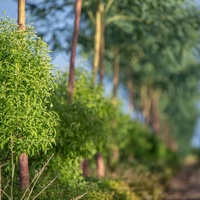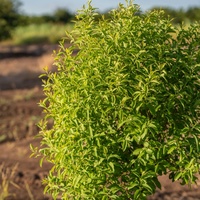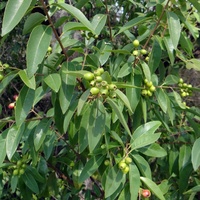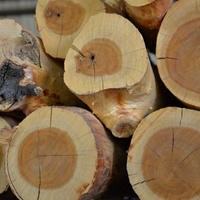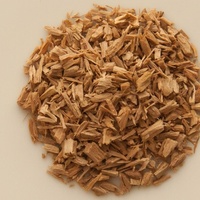Common name: Indian sandalwood
Other common names: East Indian sandalwood, Sandalwood, White sandalwood, White saunders, Yellow sandalwood, Yellow saunders
Description
Ⅰndian sandalwood, or Chandan, is an essential-oil yielding tree native to a wide geographic area, extending from India, through Sri Lanka, to Indonesia and northern Australia. Long ago introduced into Kenya, Nigeria and Uganda, it has been cultivated there with mixed success.
It is a slow-growing tree of variable size, reaching heights of up to 18 m (59 ft) in the wetter parts of its range, but rarely exceeds 4 m (13 ft) in the drier parts. On favourable sites, the tree develops a slim, straight trunk up to 30 cm (1 ft) in diameter with a rounded crown of ascending branches, which then divide into slim drooping branchlets. The bark is dark grey or near-black and rough, with thin vertical fissures.
It is an epiphyte, a plant that uses other plants as a host on which to grow, and achieves this by producing specialist roots, which seek out the roots of a host nearby. It is a very selective plant, preferring nitrogen-fixing shrubs or trees and will send out its roots up to 30 m (100 ft) in pursuit of a suitable host.
The leaves are elongated oval, 3 to 7 cm (1.2 to 2.8 in) long, pointed at the tip, dark glossy green and leathery in texture. They are arranged in pairs along the branchlets and are evergreen, remaining on the tree year-round.
The flowers are small, green when young, later purple-red and borne in clusters at the sides and ends of the branchlets. They are followed by small, roundish, dimpled fruit 0.7 to 1.0 cm (0.3 to 0.4 in) in diameter, green when young, becoming deep red then near black when ripe, with a single seed inside.
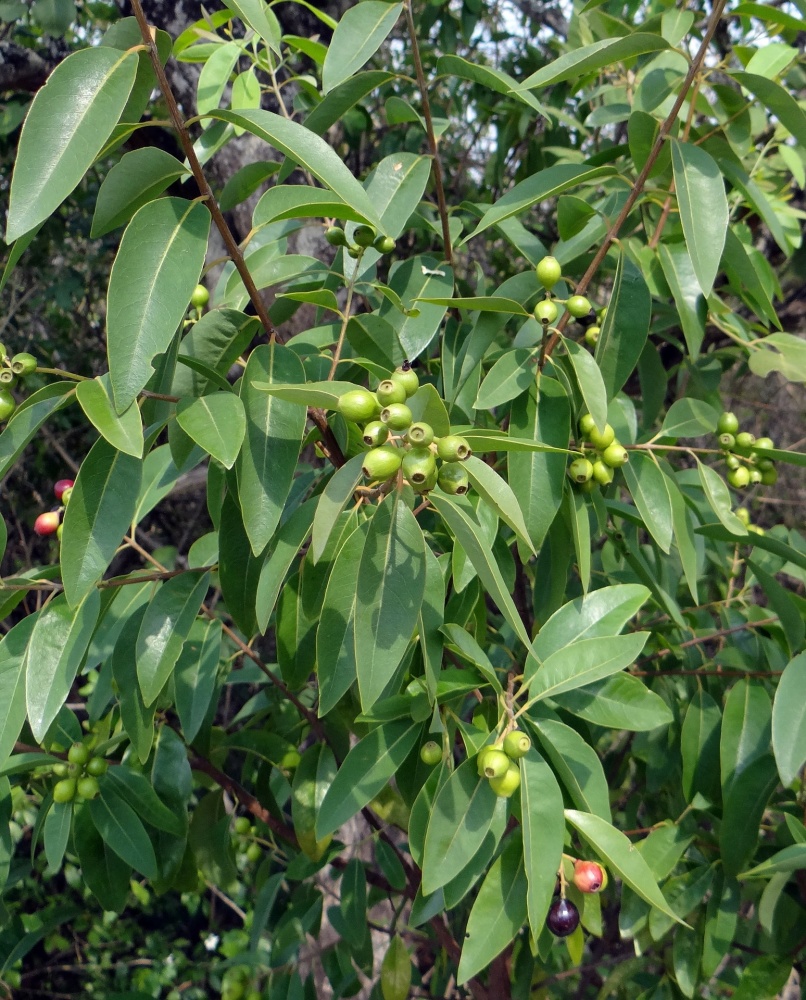
Image by Bishnu Sarangi from Pixabay
Use
The heartwood yields on steam distillation an essential-oil traded as 'Sandalwood oil'. Sandalwood oil is a clear to pale yellow, syrupy liquid, highly esteemed for its sweet, warm, woody aroma, which it retains for a long time. It has wide use as a fragrance component and fixative in perfumes and cosmetics such as creams, lotions and soaps. It is also widely used in aromatherapy and medicines and in tiny quantities as a flavouring agent in beverages, confectionery, chilled dairy desserts and baked goods.
Oil yields range from 3 to 6% of the dry weight, depending on the age and quality of the heartwood, which only develops in trees twenty years old or older. The heartwood is odourless until it has dried completely, then is strongly aromatic. The mature roots are sometimes also harvested to be distilled for oil, as they yield around 3 to 5% oil by weight.
Plantations have been established in Australia to grow trees to produce commercial quantities of Sandalwood oil, which is in increasing demand.
The heartwood is pale yellow-brown, becoming darker on exposure, fine-grained, smooth and reportedly cuts like wax, making it easily carved. It is fashioned into endless artefacts in its native range and is naturally resistant to decay and rot because of its high oil content. Some heartwood is reserved for making incense and is finely ground to a powder before being moulded into incense sticks.
The fruit are edible but considered a minor fruit. However, they are eagerly browsed on by cattle and other livestock, together with the leaves. Still, both are only of moderate value in terms of a feed or forage.
Health use
Sandalwood oil is used in aromatherapy for its relaxing, sedative and calming effects.
Climate
Grows naturally in sub-humid to moderately humid tropical lowland to mid-elevation climates, generally frost-free areas with annual lows of 18 to 24°C, annual highs of 27 to 36°C, annual rainfall of 600 to 2200 mm and a dry season of 3 to 8 months.
Although Indian Sandalwood also occurs in wetter climates, the plants put on luxurious growth at the expense of heartwood formation.
Growing
New plants are usually started from seed, which are sown in containers with a suitable host plant. Plants that have shown success as a host for Indian sandalwood seedlings include Pigeon Pea (Cajanus cajan) and the Kassod Tree (Senna siamea).
It grows on a wide range of free-draining soils, including clay-loam, loam, sandy-loam and loamy-sand, but is reported to produce heartwood with the highest oil content on thin, rocky, nutrient-poor soils. Prefers moderately acid to slightly alkaline soils, generally with a pH from 6.0 to 7.5, and sites with full to partial sun exposure.
Problem features
Birds are known to eat the fruit and disperse the seed, which germinate readily. However, reports on its weed risk are conflicting. It is assessed as a low weed risk for Florida by the IFAS Assessment of Non-Native Plants in Florida's Natural Areas, but as a high weed risk for Hawaii, by the Hawaii Pacific Weed Risk Assessment (HPWRA) project.
It sends up suckers from its roots, which may contribute to it becoming a weed.
Where it grows
References
Books
-
Arctander, S. 1960, Perfume and flavor materials of natural origin, Elizabeth, New Jersey
-
Barwick, M., et al. 2004, Tropical & subtropical trees : a worldwide encyclopaedic guide, Thames and Hudson, London
-
Brady, G. S. & Clauser, H. R & Vaccari, J. A. 2002, Materials handbook : an encyclopedia for managers, technical professionals, purchasing and production managers, technicians and supervisors, 15th ed., McGraw-Hill, New York
-
C.A.B. International 2013, The CABI encyclopedia of forest trees, CABI Publishing, Wallingford, Oxfordshire
-
Chevallier, A. 2000, Encyclopedia of herbal medicine, 2nd American ed., Dorling Kindersley, New York
-
Coppen J.J.W. 1995, Flavours and fragrances of plant origin, Non-wood forest products (Volume 1), Food and Agriculture Organization of the United Nations (FAO), Rome
-
Doran, J. C & Turnbull, J. W. 1997, Australian trees and shrubs : species for land rehabilitation and farm planting in the tropics, 2nd ed, Australian Centre for International Agricultural Research (ACIAR), Canberra, Australian Capital Territory
-
Farooqi, A. A. & Sreeramu, B. S. 2004, Cultivation of medicinal and aromatic crops, Hyderabad University Press, Hyderabad
-
Groom, N. 1997, The new perfume handbook, 2nd ed., Blackie Academic & Professional, London
-
Guenther, E. & Althausen, D. 1948 to 1952, The essential oils (6 volumes), Van Nostrand Publishing, New York
-
Hill, A. F. 1952, Economic botany : a textbook of useful plants and plant products, 2nd ed, McGraw-Hill, New York
-
Hocking, D. 1993, Trees for drylands, International Science Publisher, New York
-
Khan, I. A. & Abourashed, E. A. 2010, Leung's encyclopedia of common natural ingredients : used in food, drugs and cosmetics, 3rd edition, Wiley Publishing, Hoboken, New Jersey
-
Lopez, C. & Shanley, P., 2004. Riches of the forest: food, spices, crafts and resins of Asia, Center for International Forestry Research (CIFOR), Bogor, Indonesia
-
Luna, R. K 1996, Plantation trees, International Book Distributors, Dehradun, Uttarakhand
-
Macmillan, H. F. 1943, Tropical planting and gardening : with special reference to Ceylon, 5th ed, Macmillan Publishing, London
-
Oyen, L. P. A. & Nguyen X. D. 1999, Plant Resources of South-East Asia (PROSEA) 19 : Essential-oil plants, Backhuys Publishers, Leiden
-
Parrotta, J. A. 2001, Healing plants of peninsular India, CABI Publishing, Wallingford, Oxfordshire
-
Scheffer, T. C & Morrell, J. J. 1998, Natural durability of wood : a worldwide checklist of species, Forest Research Laboratory, Oregon State University, Corvallis, Oregon
-
Singh, R. V. 1982, Fodder trees of India, Oxford & IBH Publishing Company, New Delhi
-
Streets, R. J. & Troup, R. S. 1962, Exotic forest trees in the British Commonwealth, Oxford University Press, Oxford, England
-
Winter, R. 2009, A consumer's dictionary of cosmetic ingredients : complete information about the harmful and desirable ingredients found in cosmetics and cosmeceuticals, 7th ed, Three Rivers Press, New York

